 Fig 1. Female, dorsal view |
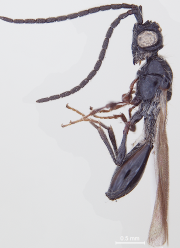 Fig 2. Male, profile |
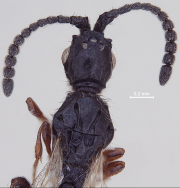 Fig 3. Head, dorsal view |
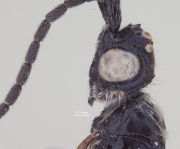 Fig 4. Head, profile |
 Fig 5. Head front view and antenna (female) |
|
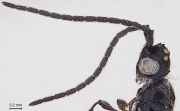 Fig 6. Antenna (male) |
 Fig 7. Forewing |
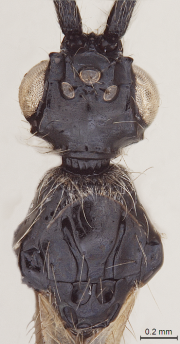 Fig 8. Head and interior mesosoma |
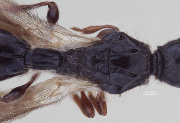 Fig 9. Mesosoma |
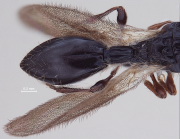 Fig 10. Metasoma |
 Fig 11. Distribution map |
|
Nomenclature
Coptera Say, 1836: 281. Type species: Coptera polita Say.
Schizogalesus Kieffer, 1911: 832, 833.
Diagnosis
Large robust forms (upto 5mm). Body usually black, rarely with shades of rustic brown, appendages much lighter in colour. Forewings often infuscate. Body smooth and shining, lacking micropilosity, but with sparse long semierect hairs. Hairy cushions on postgena, sides of pronotum and upper part of propleuron, dense, but foam-like scaly structures absent.
Head subglobular, often with ridges or ledges or pointed teeth dorsally. Antennal shelf raised, and armed. Vertex armed with variable number of spines, often with an inverted 'V' shaped ledge medially above front ocellus and a short incomplete one traversing from inner orbits towards lateral ocelli. Antennae 12-segmented in females and 14-segmented in males. Scape in both sexes distally wide, truncated and with ridges. Female antennae without a distinct clava, terminal segments gradually enlarged, A12 largest among clavomeres. Male antenna filiform, as long as or longer than body, segments cylindrical and elongate, A3 subequal to A4, A4 modified, slightly emarginate or carinate. Adorbital carina of variable length extending longitudinally on dorsal head. Mouthparts opisthognathous, mandibles protruding beaklike. Occiput step-like, occipital flange often with fine crenulae.
Cervix distinct. Pronotum with shoulders angulate. Mesoscutum with notauli pronounced, diverging in front. Humeral sulcus often well developed, suprahumeral sulcus rarely present. Anterior scutellar pits bifoveate and deep. Lateral and posterior scutellar pits also strongly indicated, sternaulus either present or absent. Dorsellum with three keels medially, propodeum sometimes elongate, with short longitudinal keels radiating from a transversely arched basal one. Median keel not produced into spine.
Wings well developed, forewing when at rest kept folded along a hairless line medially, distal margin of forewings incised, upper half longer than lower. Marginal cilia on forewings much reduced, only as long as hairs on wing disc. Venation highly reduced, only submarginal vein present, that too reaching to one-third of forewing length and placed remote from fore margin; other veins lacking. Hind wings with submarginal vein complete.
Petiole tubular, elongate and longer than wide, at times with a slight median bulge, usually with longitudinal striae, not concealed by pilosity, with dense long hairs towards lower margin.
Metasoma elongate, suboval. Only T2 visible prominently, rest of tergites telescoped under T2/large tergite. Anterior margin of T2/large tergite elevated above level of petiole and with a median incision or furrow extending to its half or three-fourth length and often with two small spot-like oval depressions anterolaterally towards margin on either side of median furrow.
Geographic Distribution
See Fig. 11 for distribution of the genus in India.
Species known from India
1. Coptera bharatvarshus (Sharma)
2. Coptera carinata Rajmohana & Narendran
3. Coptera clavata Rajmohana & Narendran
4. Coptera curvata Rajmohana & Narendran
5. Coptera dalhousieanus (Sharma)
6. Coptera lobata Rajmohana & Narendran
7. Coptera madraspatna (Sharma)
8. Coptera occispinosa Rajmohana & Narendran
9. Coptera saraswati (Sharma)
10. Coptera srinagari (Mukerjee)
11. Coptera tibiospinosa Rajmohana & Narendran
12. Coptera variegata Rajmohana & Narendran
Remarks
Represented commonly in collections. A robust body, highly raised antennal shelf, beak-like mandibles, 12-segmented antennae in females and 14-segmented in males, the former lacking an abrupt clava, vertex with ledges, or armed with spines. Notauli distinct. Anterior scutellar pit bifoveate, a straight petiole, forewing often kept folded along a hairless line medially, only an incomplete submarginal vein present and an elongate metasoma, render this genus quite unique among Diapriinae.
References
Kieffer, J. J. 1911. Species des Hyménoptères d'Europe et d'Algérie. Vol. 10. Pages 753-912. Librarie Scientifique A. Hermann & Fils, Paris. Pp.
Rajmohana, K and Bijoy, C., 2012. A checklist of Diapriidae and Proctotrupidae (Hymenoptera: Insecta) from India.
Say, T. 1836. Descriptions of new species of North American Hymenoptera, and observations on some already described. Boston Journal of Natural History, 1: 209-305, 361-416.
|